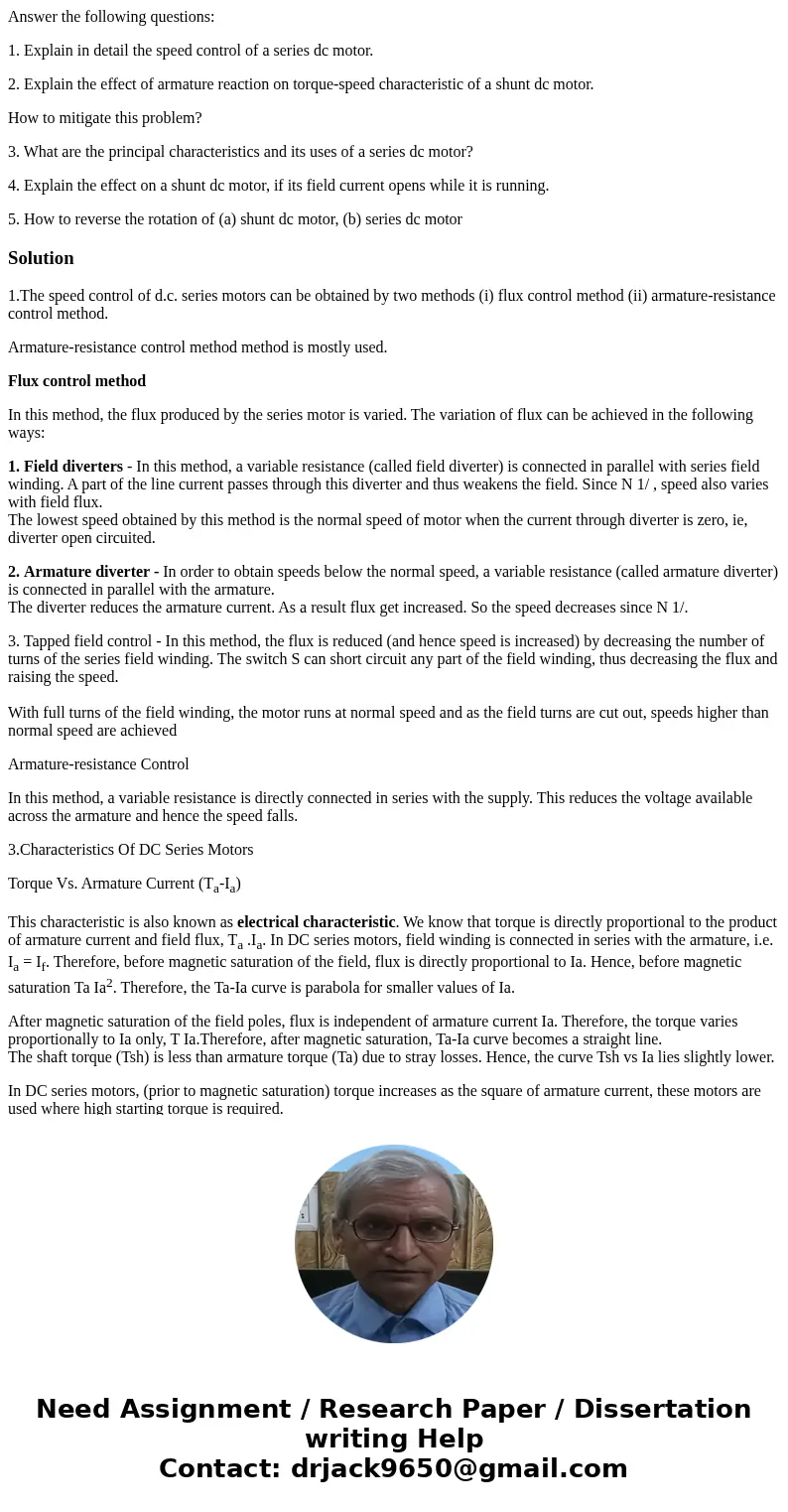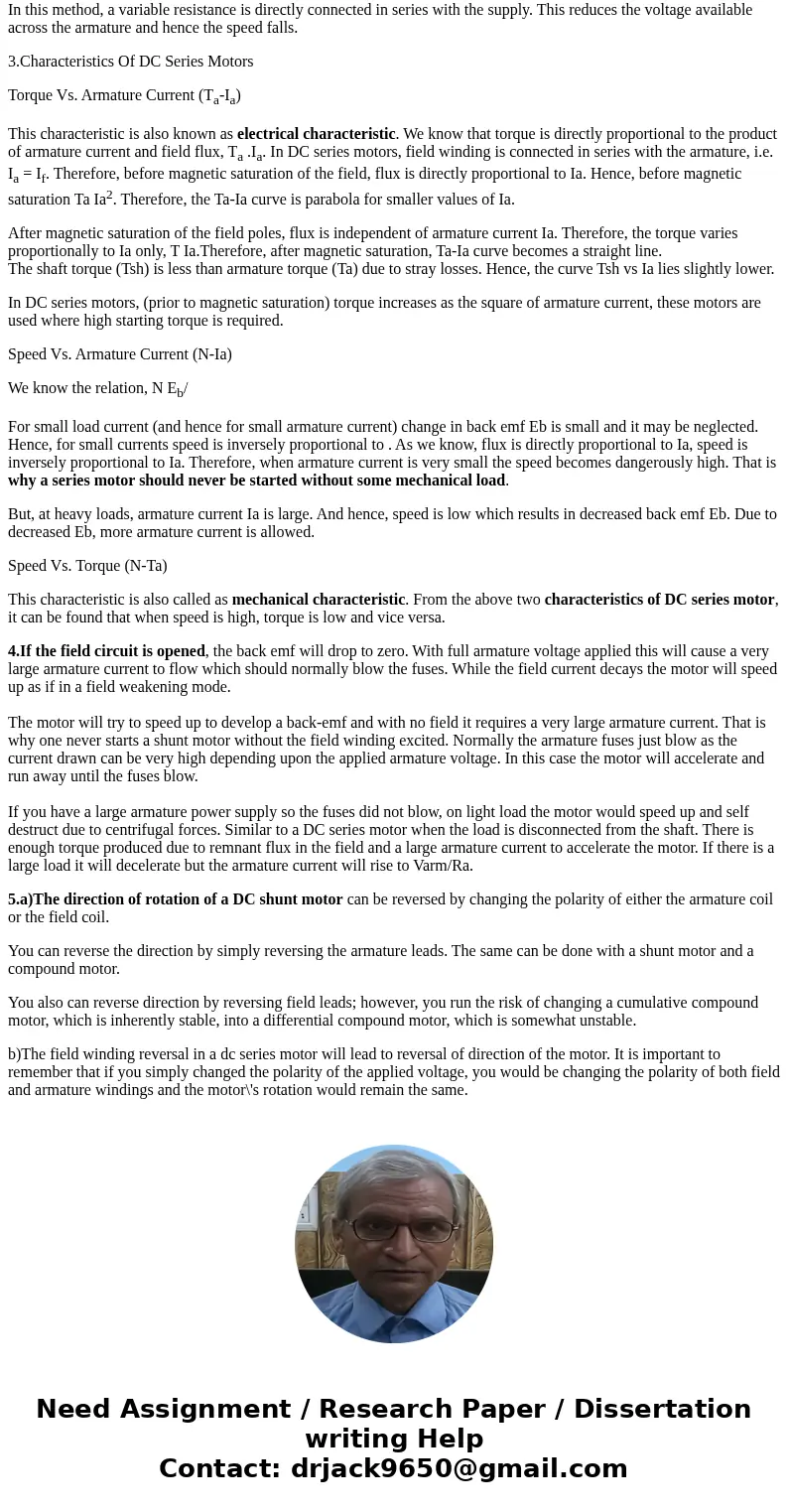Answer the following questions 1 Explain in detail the speed
Answer the following questions:
1. Explain in detail the speed control of a series dc motor.
2. Explain the effect of armature reaction on torque-speed characteristic of a shunt dc motor.
How to mitigate this problem?
3. What are the principal characteristics and its uses of a series dc motor?
4. Explain the effect on a shunt dc motor, if its field current opens while it is running.
5. How to reverse the rotation of (a) shunt dc motor, (b) series dc motor
Solution
1.The speed control of d.c. series motors can be obtained by two methods (i) flux control method (ii) armature-resistance control method.
Armature-resistance control method method is mostly used.
Flux control method
In this method, the flux produced by the series motor is varied. The variation of flux can be achieved in the following ways:
1. Field diverters - In this method, a variable resistance (called field diverter) is connected in parallel with series field winding. A part of the line current passes through this diverter and thus weakens the field. Since N 1/ , speed also varies with field flux.
The lowest speed obtained by this method is the normal speed of motor when the current through diverter is zero, ie, diverter open circuited.
2. Armature diverter - In order to obtain speeds below the normal speed, a variable resistance (called armature diverter) is connected in parallel with the armature.
The diverter reduces the armature current. As a result flux get increased. So the speed decreases since N 1/.
3. Tapped field control - In this method, the flux is reduced (and hence speed is increased) by decreasing the number of turns of the series field winding. The switch S can short circuit any part of the field winding, thus decreasing the flux and raising the speed.
With full turns of the field winding, the motor runs at normal speed and as the field turns are cut out, speeds higher than normal speed are achieved
Armature-resistance Control
In this method, a variable resistance is directly connected in series with the supply. This reduces the voltage available across the armature and hence the speed falls.
3.Characteristics Of DC Series Motors
Torque Vs. Armature Current (Ta-Ia)
This characteristic is also known as electrical characteristic. We know that torque is directly proportional to the product of armature current and field flux, Ta .Ia. In DC series motors, field winding is connected in series with the armature, i.e. Ia = If. Therefore, before magnetic saturation of the field, flux is directly proportional to Ia. Hence, before magnetic saturation Ta Ia2. Therefore, the Ta-Ia curve is parabola for smaller values of Ia.
After magnetic saturation of the field poles, flux is independent of armature current Ia. Therefore, the torque varies proportionally to Ia only, T Ia.Therefore, after magnetic saturation, Ta-Ia curve becomes a straight line.
The shaft torque (Tsh) is less than armature torque (Ta) due to stray losses. Hence, the curve Tsh vs Ia lies slightly lower.
In DC series motors, (prior to magnetic saturation) torque increases as the square of armature current, these motors are used where high starting torque is required.
Speed Vs. Armature Current (N-Ia)
We know the relation, N Eb/
For small load current (and hence for small armature current) change in back emf Eb is small and it may be neglected. Hence, for small currents speed is inversely proportional to . As we know, flux is directly proportional to Ia, speed is inversely proportional to Ia. Therefore, when armature current is very small the speed becomes dangerously high. That is why a series motor should never be started without some mechanical load.
But, at heavy loads, armature current Ia is large. And hence, speed is low which results in decreased back emf Eb. Due to decreased Eb, more armature current is allowed.
Speed Vs. Torque (N-Ta)
This characteristic is also called as mechanical characteristic. From the above two characteristics of DC series motor, it can be found that when speed is high, torque is low and vice versa.
4.If the field circuit is opened, the back emf will drop to zero. With full armature voltage applied this will cause a very large armature current to flow which should normally blow the fuses. While the field current decays the motor will speed up as if in a field weakening mode.
The motor will try to speed up to develop a back-emf and with no field it requires a very large armature current. That is why one never starts a shunt motor without the field winding excited. Normally the armature fuses just blow as the current drawn can be very high depending upon the applied armature voltage. In this case the motor will accelerate and run away until the fuses blow.
If you have a large armature power supply so the fuses did not blow, on light load the motor would speed up and self destruct due to centrifugal forces. Similar to a DC series motor when the load is disconnected from the shaft. There is enough torque produced due to remnant flux in the field and a large armature current to accelerate the motor. If there is a large load it will decelerate but the armature current will rise to Varm/Ra.
5.a)The direction of rotation of a DC shunt motor can be reversed by changing the polarity of either the armature coil or the field coil.
You can reverse the direction by simply reversing the armature leads. The same can be done with a shunt motor and a compound motor.
You also can reverse direction by reversing field leads; however, you run the risk of changing a cumulative compound motor, which is inherently stable, into a differential compound motor, which is somewhat unstable.
b)The field winding reversal in a dc series motor will lead to reversal of direction of the motor. It is important to remember that if you simply changed the polarity of the applied voltage, you would be changing the polarity of both field and armature windings and the motor\'s rotation would remain the same.


 Homework Sourse
Homework Sourse